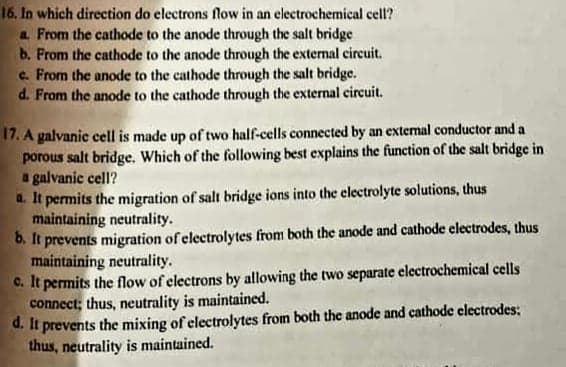16. In which direction do electrons flow in an electrochemical cell? a From the cathode to the anode through the salt bridge b. From the cathode to the anode through the external circuit. c. From the anode to the cathode through the salt bridge. d. From the anode to the cathode through the external circuit. 17. A galvanic cell is made up of two half-cells connected by an external conductor and a porous salt bridge. Which of the following best explains the function of the salt bridge in a galvanic cell? a. It permits the migration of salt bridge ions into the electrolyte solutions, thus maintaining neutrality. b. It prevents migration of electrolytes from both the anode and cathode electrodes, thus maintaining neutrality. C. It permits the flow of electrons by allowing the two separate electrochemical cells connect; thus, neutrality is maintained. d. It prevents the mixing of electrolytes from both the anode and cathode electrodes: thus, neutrality is maintained.
16. In which direction do electrons flow in an electrochemical cell? a From the cathode to the anode through the salt bridge b. From the cathode to the anode through the external circuit. c. From the anode to the cathode through the salt bridge. d. From the anode to the cathode through the external circuit. 17. A galvanic cell is made up of two half-cells connected by an external conductor and a porous salt bridge. Which of the following best explains the function of the salt bridge in a galvanic cell? a. It permits the migration of salt bridge ions into the electrolyte solutions, thus maintaining neutrality. b. It prevents migration of electrolytes from both the anode and cathode electrodes, thus maintaining neutrality. C. It permits the flow of electrons by allowing the two separate electrochemical cells connect; thus, neutrality is maintained. d. It prevents the mixing of electrolytes from both the anode and cathode electrodes: thus, neutrality is maintained.
Chemistry by OpenStax (2015-05-04)
1st Edition
ISBN:9781938168390
Author:Klaus Theopold, Richard H Langley, Paul Flowers, William R. Robinson, Mark Blaser
Publisher:Klaus Theopold, Richard H Langley, Paul Flowers, William R. Robinson, Mark Blaser
Chapter17: Electrochemistry
Section: Chapter Questions
Problem 22E: The mass of three different metal electrodes, each from a different galvanic cell, were determined...
Related questions
Question

Transcribed Image Text:16. In which direction do electrons flow in an electrochemical cell?
a From the cathode to the anode through the salt bridge
b. From the cathode to the anode through the external circuit.
c. From the anode to the cathode through the salt bridge.
d. From the anode to the cathode through the external circuit.
17. A galvanic cell is made up of two half-cells connected by an external conductor and a
porous salt bridge. Which of the following best explains the function of the salt bridge in
a galvanic cell?
a. It permits the migration of salt bridge ions into the electrolyte solutions, thus
maintaining neutrality.
6. It prevents migration of electrolytes from both the anode and cathode electrodes, thus
maintaining neutrality.
C. It permits the flow of electrons by allowing the two separate electrochemical cells
connect; thus, neutrality is maintained.
d. It prevents the mixing of electrolytes from both the anode and cathode electrodes:
thus, neutrality is maintained.
Expert Solution
This question has been solved!
Explore an expertly crafted, step-by-step solution for a thorough understanding of key concepts.
This is a popular solution!
Trending now
This is a popular solution!
Step by step
Solved in 2 steps

Knowledge Booster
Learn more about
Need a deep-dive on the concept behind this application? Look no further. Learn more about this topic, chemistry and related others by exploring similar questions and additional content below.Recommended textbooks for you

Chemistry by OpenStax (2015-05-04)
Chemistry
ISBN:
9781938168390
Author:
Klaus Theopold, Richard H Langley, Paul Flowers, William R. Robinson, Mark Blaser
Publisher:
OpenStax

General Chemistry - Standalone book (MindTap Cour…
Chemistry
ISBN:
9781305580343
Author:
Steven D. Gammon, Ebbing, Darrell Ebbing, Steven D., Darrell; Gammon, Darrell Ebbing; Steven D. Gammon, Darrell D.; Gammon, Ebbing; Steven D. Gammon; Darrell
Publisher:
Cengage Learning

Chemistry: Matter and Change
Chemistry
ISBN:
9780078746376
Author:
Dinah Zike, Laurel Dingrando, Nicholas Hainen, Cheryl Wistrom
Publisher:
Glencoe/McGraw-Hill School Pub Co

Chemistry by OpenStax (2015-05-04)
Chemistry
ISBN:
9781938168390
Author:
Klaus Theopold, Richard H Langley, Paul Flowers, William R. Robinson, Mark Blaser
Publisher:
OpenStax

General Chemistry - Standalone book (MindTap Cour…
Chemistry
ISBN:
9781305580343
Author:
Steven D. Gammon, Ebbing, Darrell Ebbing, Steven D., Darrell; Gammon, Darrell Ebbing; Steven D. Gammon, Darrell D.; Gammon, Ebbing; Steven D. Gammon; Darrell
Publisher:
Cengage Learning

Chemistry: Matter and Change
Chemistry
ISBN:
9780078746376
Author:
Dinah Zike, Laurel Dingrando, Nicholas Hainen, Cheryl Wistrom
Publisher:
Glencoe/McGraw-Hill School Pub Co

Chemistry for Engineering Students
Chemistry
ISBN:
9781337398909
Author:
Lawrence S. Brown, Tom Holme
Publisher:
Cengage Learning


World of Chemistry, 3rd edition
Chemistry
ISBN:
9781133109655
Author:
Steven S. Zumdahl, Susan L. Zumdahl, Donald J. DeCoste
Publisher:
Brooks / Cole / Cengage Learning